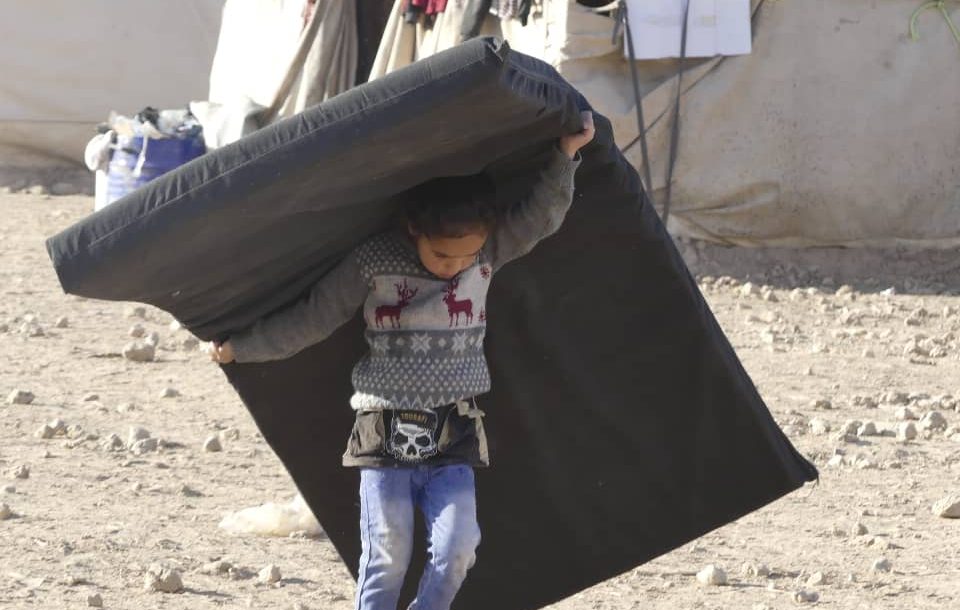IDPs of Serê Kaniyê (Ras Al-Ain) reject shelters, remaining optimistic to return to their city.
Akhten Asa’ad

No one can grasp the consequences of one’s reactions when the lives of family members are at serious risk, Serbest thinks as he gathers his family members inside his small car and takes them out of the city of Serê Kaniyê (Ras Al-Ain) while the Turkish artillery targets civilians in a large-scale attack.
Serbest’s family consists of him, his wife and four children: three young girls and a seven-year-old boy, who endured a very tough journey of displacement for three long days. The family fled to the town of Tal Tamer, then to the city of Hasaka, and then finally settled in the town of Girkê Legê, in the far northeast of the country.
It took three days to travel roughly 200 km, until they eventually settled inside a school in Girkê Legê. There wasn’t available room to accommodate Serbest’s family, so he had to make a small tent under the shade of his car. Their situation isn’t far from living on the street, except for the fact there is a nearby wall which provides some privacy, providing protection from the gaze of passersby. “I didn’t exactly know what to do then. The most important thing at that time was that no one in my family got hurt. The shelling was very intense and affected everything. Only now can I feel safe because I succeeded in bringing my children to safety. The loss of our house or the furniture doesn’t matter,” Serbest says with heartache.
In the school yard, in the town of Girkê Legê, a fifty-year-old woman appears to have lost someone and can no longer find him. “I do not have any news about my brother and my son, both are SDF fighters. I left with my children in a neighbor’s car without carrying anything but the clothes we wear,” Thuraya says to Shar, as she reflects carefully on her city’s residents flight from the bombing.
Mustafa Buzan, a father of three children who also fled with his family from Serê Kaniyê (Ras Al-Ain), doesn’t hide his tears while talking about what they went through. He describes what happened to them as ethnic cleansing: “Could the Turkish artillery and warplanes distinguish between civilians and military?” Mustafa does not have any answers for his children, who ask insistently whether they can return to the village they left under the sound of shelling.
Displacement for the third time
Forty-year-old Sardar, from a village near Serê Kaniyê (Ras Al-Ain), had been displaced once in 2012 to the city of Kobanê, escaping the radical Islamic factions that had attacked the city at that time. He then returned once again to his city, only to find himself escaping ISIS again. Sardar has now come to a shelter in Girkê Legê. He can not find any reason people are being targeted except because they are Kurds. “We’re going back to Serê Kaniyê. It’s our land, our roots that no one can tear out from us. It may take time, but I’m sure it will be like the first time I came back,” Sardar says, confident and optimistic about returning to his city.
Among these IDPs, you may hear too many stories which seem like the story of Sardar, Mustafa, and Thuraya. They all suffer the loss of their land and dream of returning. Their suffering has become very difficult, while Islamic radical factions controlling the city, claim they are “liberating” it. The factions invade territory that does not belong to them, they take over houses which are not theirs, and have forced thousands of people to flee their homes.
Some residents from Serê Kaniyê, believing they could return to their homes as long as they were not military, tried to return to the city, but the roads were closed. The Islamic radical factions are kidnapping civilians and demanding ransom in order to collect money. This was the case when some people tried to enter the city, while factions are able to kill indiscriminately whomever dares enter the city. This happened to an old man who lost his life to a sniper bullet when he refused to leave his home.
Schools to accommodate the displaced.. Crisis of three hundred thousand IDPs causes a crisis in the field of education
The displacement of 300,000 people from Serê Kaniyê (Ras Al-Ain) and Girê Sipî (Tel Abyad) has directly impacted the reality of education in the cities that have received them. One hundred schools have been converted into shelters in the cities of Hasaka, Tal Tamer, Qamishlo and Karki Laki, according to the Education Authority of the Self-Administration of Northeast Syria.
In the city of Hasaka and its countryside, there are more than 60 schools inhabited by roughly 20,000 IDPs, which has disrupted the educational process and deprived 60,000 students of education. Similarly, another 25,000 students from Serê Kaniyê have been out of school since the Turkish invasion destroyed twenty-five schools, while the rest of the city’s schools have become military locations for Turkish-led terrorist factions.
Serê Kaniyê IDPs are divided into key points. The first one is Nawroz camp, in the far north-east of the city of Dêrik, which holds 35 families, or about 200 people. The second location is Al-Twena camp, more recently referred to as Washo Kani camp, located near the village of Al-Twena, on the road between Hasaka and Tal Tamer. The number of IDPs in the first camp has reached about one thousand IDPs. In addition, there are 70 shelters distributed in different cities that hold about 20,000 IDPs.
IDPs hope to return to their homes soon, as they suffer enormous sorrow and grief, increasingly spending their days in shelters and camps since invaders robbed them of all they have.
